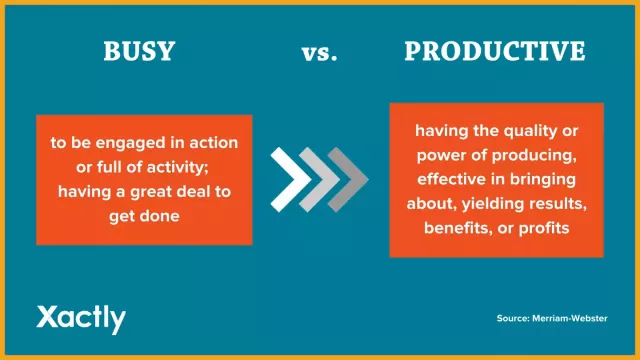
Remember the classic I Love Lucy scene with the chocolate factory conveyor belt? The one where the candies are moving so quickly that Lucy and Ethel abandon all attempts to package them and start stashing chocolates wherever they can to keep the belt clear? If you just looked at how many candies were cleared from the belt, you’d say Lucy and Ethel were pretty productive. But in reality, their actions weren’t making any progress towards achieving their goal of packaged sweets.
In sales, we often measure reps on concrete actions: how many calls they dial out each day, the number of outreach emails they send in the quarter, etc. But is that really the most effective way to measure their productivity or the right metrics to base their sales incentives on?
According to Method:CRM, the average salesperson spends only 32 percent of their time selling. The rest of their time is spent on administrative tasks. While many of these non-selling tasks are necessary to run a successful revenue organization, they take away valuable time from the actions that really make a difference in closing deals. And if you’re only measuring reps on the total number of actions they complete in a period, you can’t truly see how effective those actions are at moving the needle towards your revenue targets.
That poses two major questions for sales leaders: Are you sales reps really productive or are they just busy? And are you motivating them for the right behaviors?
What are you really rewarding your sales team for?
72 percent of sales professionals feel they’ve remained productive throughout the COVID-19 pandemic, according to the 2020 Salesforce State of Sales report. But if 68 percent of their time is spent on non-selling tasks, how productive are they really?
We often tend to assume that the busiest people are the most productive. They check the most tasks off their to-do lists and are consumed day in and day out with work-related activities. But when you consider the difference between busyness and productivity, that’s not quite the case. So let’s consult our old pal Merriam-Webster.
Focus on the last part of the definition of productive: yielding results, benefits, or profits. This is where busyness versus productivity is critical in sales. Ideally, every action reps take should yield results that help generate profits. You want your sales team to take actions that help deals progress, close, and bring in revenue.
Ask yourself this: are you rewarding behaviors that drive revenue? Or is your incentive plan merely encouraging reps to make 150 phone calls in a given period of time, regardless of the impact on sales pipeline?
Here are some additional questions to get you started in the right direction:
- Which sales actions contribute to overarching company goals?
- What rep tasks have the biggest impact on your progress towards targets?
- Are there any processes or tasks that you can automate or eliminate to free up rep selling time?
And if your plan is performing well enough to hit your goals, ask yourself this: What if you could produce the same results with less effort and fewer resources? If you could generate more revenue from the level of effort you’re asking of your sales team now, why wouldn’t you?
5 Tips to Improve Sales Productivity
Improving sales productivity starts with understanding where you can improve your existing revenue and incentive processes. Here are five steps to get started.
1. Get sales reps involved from the start.
The best way to create an organization that helps reps sell better is to figure out what your team needs in order to sell more effectively. Gather rep feedback on their work environments, training sessions, enablement materials, incentive plans, etc.
This empowers them to work in the most productive way possible and have the tools and resources they need to hit their quota. It also ensures they understand goals laid out in the comp plan and the actions they need to take to succeed.
2. Clearly communicate goals and priorities.
Salesforce reports that 91 percent of sales over-performers say leadership has communicated business priorities clearly, compared to 78 percent of underperformers. Again, clarity amongst the sales team is essential. They must be able to prioritize accounts, deals, and actions in order to make progress towards their individual quota and contribute to company goals.
A good place to start is by optimizing your sales plan rollout strategy so you can effectively communicate from the start and have the processes in place to continuously analyze performance.
3. Rethink how you’re designing sales incentives.
When building sales compensation plans, there are several factors you need to consider. You want incentives to be motivating, but push reps to succeed, and ideally, exceed their quota. Here are a few best practices to consider. Your incentives should:
- Be aligned with goals and individual sales roles
- Drive the right behaviors that will result in the highest performance
- Be simple, straightforward, and easy-to-understand
- Be benchmarked against industry data to ensure they’re competitive enough to attract and retain top talent
4. Invest in Incentive Compensation Management (ICM)
Managing incentives is a critical piece of successful revenue organizations. Manually calculating compensation can take upwards of six weeks to complete, which is a waste of valuable time and resources. More than half of companies (58%) are using some form of Incentive Compensation Management (ICM) solution to automate their workflow and administrative processes, according to the 2020 Salesforce State of Sales study.
ICM helps you better measure the effectiveness of your incentives, allowing for continuous analysis and faster decision making. And when automating complex compensation administration processes, Salesforce also reports that organizations see a 30 percent increase in closed/won deals.
5. Make digital transformation a top priority.
The most successful revenue-driven organizations realize that it takes more than just optimized compensation. It takes efficiency across the entire organization. The most effective way to achieve this is to eliminate unnecessary workflow and process kinks through digital transformation.
In 2020 alone, more than two-thirds of companies took action to further accelerate their digital adoption and automation efforts. But it’s important to remember that technology is merely an enabler. You don’t just automate to automate. You invest in digital transformation to better understand your performance, sales cycles, and pipeline in order to drive more revenue.
Gartner reports that using digital transformation tools like a Sales Performance Management (SPM) solution can ultimately improve sales productivity by more than 12 percent. How? The best SPM tools are integrated, data-driven, and empower you to turn your data into actionable insights.
Driving Revenue with Higher Productivity
Quality is far more important than quantity when it comes to measuring sales productivity. The focus should be on revenue-driving activities that move deals in the right direction, rather than the number of actions a rep takes. If a salesperson can move a new lead to the next sales stage in two calls instead of the five that their quota calls for, reward that efficiency and aim to replicate it across your entire team.
The goal must always be to produce better results, not more actions and effort. Your incentive compensation should reinforce this and motivate behaviors that move the needle towards your revenue targets. Automating with Sales Performance Management helps improve process efficiency and ultimately frees up critical selling time that reps and leaders are losing out on. And when you’re not muddling through administrative tasks, you are able to really hone in on data-driven strategies that maximize performance and transform your team into a revenue-driving machine.
Discover how you can maximize your sales productivity and increase your revenue-driving activities in our webinar, “Supercharge Your Commission Planning with Salesforce + Xactly.”






